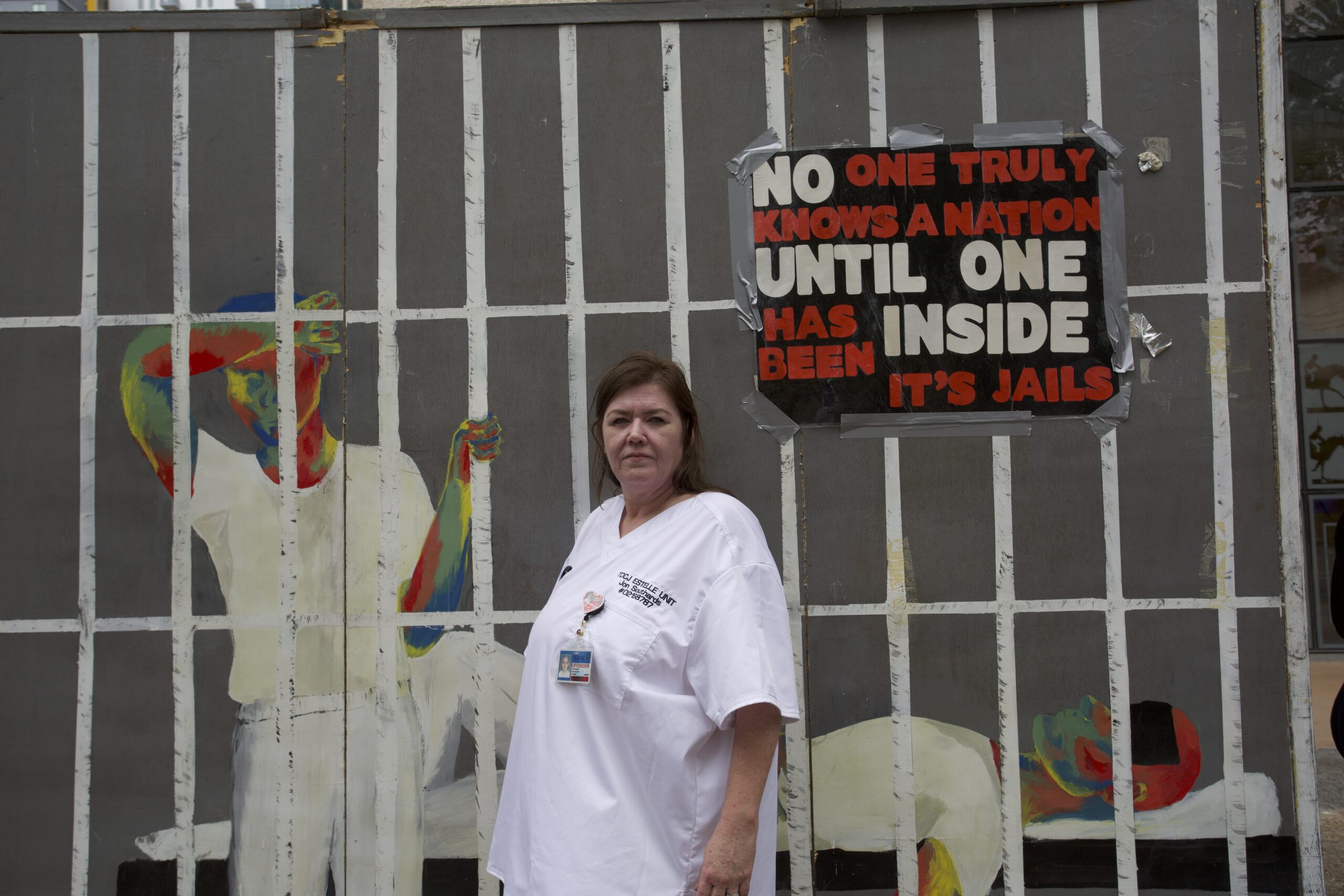Book Review
Shooting, Eating, and . . . in San Antonio
In his premiere novel, Beaumont novelist and Lamar State University Professor Jim Sanderson established himself as a crime novelist who understood very well how to manipulate the formula of the modern cops-and-robbers thriller. El Camino Del Rio (1998) was sufficiently well wrought to win the first Frank Waters Southwest Writing Award, and to gain for Sanderson a multiple book contract from the University of New Mexico Press.
El Camino del Rio predictably finds its setting on the deep southwestern Texas border with Mexico. Sanderson chose for a protagonist a half-Hispanic, half-Anglo United States Border Patrol officer, Dolph Martínez, who quickly finds himself embroiled in a triple-cross involving illegal aliens, smuggled contraband, and a gorgeous and mysterious and sexually liberated woman. There is also a former nun turned curandera, who leads him indirectly to a point where he is forced to come to terms with his professional responsibilities and also with himself. In El Camino, Sanderson fully captures the ambiance of the border country: a hard-scrabble, lonely and rugged place tucked away in the bend of the Rio Grande. The people and geography of that remote region are revealed under Sanderson’s pen in a sometimes all-too-frank light, that exposes both the beauty and the ugliness of a place where freewheeling lifestyles and frontier justice continue to flourish in a world of high technology and increasing legal repression of personal rights.
Now, in a second crime thriller, the San Antonio native turns his attention to the contemporary Alamo City. In Safe Delivery Sanderson presents a thorny and complicated story involving Mexican gun-runners, revolution, and aging cops and gangsters, all of whom are thrown together in a circular plot that finds its center in the lovely and intrepid private investigator, Jerri Johnson.
The blonde and sensuous Johnson, a former schoolteacher turned tour guide, and now working as a skip-tracer for a bail bondsman, is comfortably installed in her newfound profession when an old lover turns up. Vincent Fuentes, the son of a former Mexican strong man turned respectable citizen, wants Johnson’s help in smuggling some stolen automatic rifles from the United States to potential revolutionaries in Mexico. Fuentes, a former priest turned revolutionary, is a confirmed drunk with astounding sexual appetites. He has also developed a reputation as a writer, and has convinced the powers that be at prestigious Trinity University to hire him. This provides him with a cover to mask his solicitation of Johnson’s help, while he wows the artsy “dowagers” of San Antonio with his charm and fading talent.
What Johnson doesn’t know is that Fuentes, who’s great in the sack, is working under duress for the ruling Mexican political party, the PRI, which is using the whole gun-running scheme as an excuse to eliminate the malcontents who want the guns in the first place. His cooperation was solicited by beatings he received at the hands of the Mexican police, who now want to use him as a kind of double agent. But he has other plans.
Fuentes, of course, is a fool, dependent on alcohol and sex for an identity denied to him by his father, Palo, who has disowned him. (When he’s not cracking pecans or eating ice cream, Palo runs a successful business smuggling undocumented aliens across the River.) The supposed revolutionaries are, as it turns out, a collection of marginally honest citizens who have become entangled in a property dispute with the local authorities, and who, in their frustration, have permitted Fuentes to talk them into taking a violent stand to protect their Civic Recreation Center from being bulldozed in the name of progressive development. This, the alcohol-deluded Fuentes hopes, will spark an urban revolution that will spirit the PRI out of power and create a new nationalistic presence in Mexico. He also hopes that his “nonfiction prose” will stimulate support from sympathetic Americans, who appear more interested in the symphony and potholes in San Antonio’s streets than in Mexico.
Fuentes’ movements are being monitored by one Joe Parr. Parr is apparently an old Texas Ranger who is, somehow, working for the San Antonio Police Department, although he also seems to represent himself as an agent of the federal government. The nearsighted Parr (who, we are reminded often, resembles the late John Connally), has been farmed out to useless cases and an isolated office until he officially retires. Despite a lack of interest on the part of American authorities, Parr is dedicated to bringing Fuentes to justice. Like virtually every male in the novel, Parr is smitten by the forty-something Johnson, even though he fears that, ultimately, he will have to arrest her along with Fuentes.
Flitting about in the background are also some thugs, gunsels, and secret agents from Mexico, a collection of coyotes, drug smugglers, and minor street hoods, politically-minded San Antonio cops, prostitutes, bartenders, and, not incidentally, the ghost of Parr’s wife, who frequently visits him to have a cup of tea and advise him on the conflict he feels between his heart (and desire) and his loyalty to the badge.
As Sanderson weaves this plot into the intricacy of a well-made serape, he takes time out to comment on the setting and background of old San Antonio. His narrative antipathy toward the recent changes in the city’s demography is often hilarious and, for any who know the old town, a touch sad. He outlines the bittersweet realities of enforced changes in the façade of a city that out of fiscal necessity has laid itself open to the incursion of hoards of tourists, snowbirds, and rust-belt immigrants with their yuppie ways and modern demands, while trying to preserve something of its historical and cultural integrity. At the same time, though, he is hard on the traditional city government, which has permitted the urban infrastructure to deteriorate in the wake of glitzy and shallow improvements, and which ignores the urban blight while it pours millions into the fashionable suburbs of the North Side.
Sanderson’s knowledge of San Antonio, and the racial, social, and economic tensions under which the city sags and moans into the twenty-first century, is incisive. But beneath the veneer of progress, and the shiny glass and steel, faux stonework, and labyrinthine freeway systems, his Alamo City characters still express through their habits and comments their profound love of the old San Antonio that longtime citizens so fondly remember. His characters especially love the food; indeed, one might say that virtually all these people do is eat. The novel could almost pass as a culinary guide to the best cooking the Alamo City has to offer, although the names of some extant restaurants are not correctly rendered, and the best of them are omitted.
As the plot continues to spin toward a resolution, Parr must reconcile his conflicts of the heart and head, while Johnson seeks some way out of the dilemma into which her former lover has placed her. She is as taken with Parr and his more mature approaches to sexual gratification, as she is obsessed with the torch she carries for the carnally talented Fuentes. All the while, the evil denizens of crime and political machinations swirl around the steamy San Antonio climate like so many clouds of angry mosquitoes, while the marginal “good guys” attempt to find a way out of the mess into which international intrigue has placed them.
Although often marred by grammatical gaffes, repetitive passages, numerous stale jokes and clichés, and not a few geographic errors, Safe Delivery indicates that Jim Sanderson has a particular talent for building an intricate plot into a solid pattern of complex human relationships. He is clearly making his mark as a significant contributor to the canon of Texas crime fiction, and there is little doubt that there will be more border intrigue emerging from his imagination.
Clay Reynolds lives in North Texas, and teaches at U.T.—Dallas. His new novel is Monuments (Texas Tech University Press).


